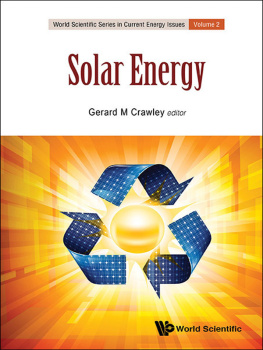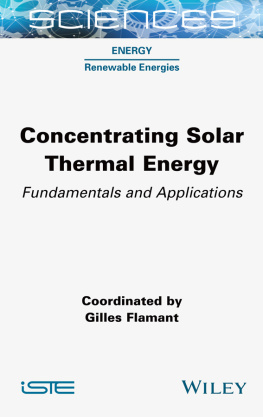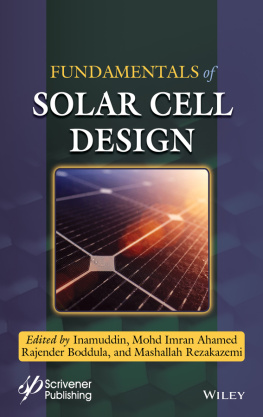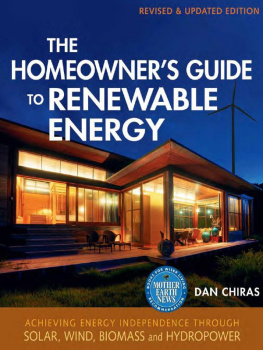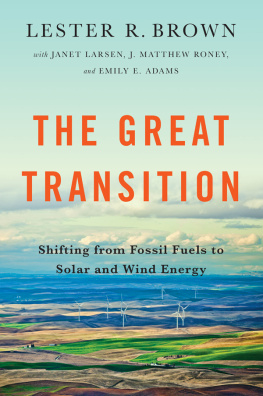Table of Contents
Pagebreaks of the print version

World Scientific Series in Current Energy Issues Volume 2
Solar Energy
World Scientific Series in Current Energy Issues
Series Editor: Gerard M Crawley (University of South Carolina & Marcus Enterprise LLC, USA)
Published
Vol. 1Fossil Fuels: Current Status and Future Directions
edited by Gerard M Crawley
Vol. 2Solar Energy
edited by Gerard M Crawley
Forthcoming
Energy from the Nucleus: The Science and Engineering of Fission and Fusion
edited by Gerard M Crawley
World Scientific Series in Current Energy Issues Volume 2
Solar Energy
Editor
Gerard M Crawley
Marcus Enterprise LLC, USA
&
Professor and Dean Emeritus
University of South Carolina, USA

Published by
World Scientific Publishing Co. Pte. Ltd.
5 Toh Tuck Link, Singapore 596224
USA office: 27 Warren Street, Suite 401-402, Hackensack, NJ 07601
UK office: 57 Shelton Street, Covent Garden, London WC2H 9HE
Library of Congress Cataloging-in-Publication Data
Names: Crawley, Gerard M., editor.
Title: Solar energy / [compiled by] Gerard M Crawley (University of South Carolina, USA & Marcus Enterprise LLC, USA).
Other titles: Solar energy (World Scientific (Firm))
Description: [Hackensack] New Jersey : World Scientific, 2016. |
Series: World Scientific series in current energy issues ; vol. 2 |
Includes bibliographical references.
Identifiers: LCCN 2015031779 | ISBN 9789814689496 (alk. paper)
Subjects: LCSH: Solar energy.
Classification: LCC TJ810 .S488175 2016 | DDC 621.47--dc23
LC record available at http://lccn.loc.gov/2015031779
British Library Cataloguing-in-Publication Data
A catalogue record for this book is available from the British Library.
Copyright 2016 by World Scientific Publishing Co. Pte. Ltd.
All rights reserved. This book, or parts thereof, may not be reproduced in any form or by any means, electronic or mechanical, including photocopying, recording or any information storage and retrieval system now known or to be invented, without written permission from the publisher .
For photocopying of material in this volume, please pay a copying fee through the Copyright Clearance Center, Inc., 222 Rosewood Drive, Danvers, MA 01923, USA. In this case permission to photocopy is not required from the publisher.
In-house Editor: Dipasri Sardar
Typeset by Stallion Press
Email:
Printed in Singapore
Foreword to the World Scientific Series on Current Energy Issues
Gerard M. Crawley
Sometime between four hundred thousand and a million years ago, an early humanoid species developed the mastery of fire and changed the course of our planet. Still, as recently as a few hundred years ago, the energy sources available to the human race remained surprisingly limited. In fact, until the early 19th century, the main energy sources for humanity were biomass (from crops and trees), their domesticated animals and their own efforts.
Even after many millennia, the average per capita energy use in 1830 only reached about 20 Gigajoules (GJ) per year. By 2010, however, this number had increased dramatically to 80 GJ per year. One reason for this notable shift in energy use is that the number of possible energy sources increased substantially during this period, starting with coal in about the 1850s and then successively adding oil and natural gas. By the middle of the 20th century, hydropower and nuclear fission were added to the mix. As we move into the 21st century, there has been a steady increase in other forms of energy such as wind and solar, although presently they represent a relatively small fraction of world energy use.
Despite the rise of a variety of energy sources, per capita energy use is not uniform around the world. There are enormous differences from country to country, pointing to a large disparity in wealth and opportunity (see The general trends over the last decade suggest that countries with developed economies generally show modest increases or even small decreases in energy use, but that developing economies, particularly China and India, are experiencing rapidly increasing energy consumption per capita.
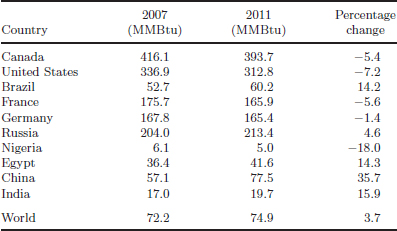
These changes, both in the kind of resource used and the growth of energy use in countries with developing economies, will have enormous effects in the near future, both economically and politically, as greater numbers of people compete for limited energy resources at a viable price. A growing demand for energy will have an impact on the distribution of other limited resources such as food and fresh water as well. All this leads to the conclusion that energy will be a pressing issue for the future of humanity.
Another important consideration is that all energy sources have disadvantages as well as advantages, risks as well as opportunities, both in the production of the resource and in its distribution and ultimate use. Coal, the oldest of the new energy sources, is still used extensively to produce electricity, despite its potential environmental and safety concerns in mining both underground and open cut mining. Burning coal releases sulphur and nitrogen oxides which in turn can leads to acid rain and a cascade of detrimental consequences. Coal production requires careful regulation and has not had the growth predicted because of the problem with long term storage of the waste from nuclear reactors and because of the public perception regarding the danger of catastrophic accidents such as happened at Chernobyl in 1986 and at Fukushima in 2011.
Even more recently, the measured amount of carbon dioxide, a greenhouse gas, in the global atmosphere has steadily increased and is now greater than 400 parts per million (ppm). that this increase in CO2 will produce an increase in global temperatures. We will see a rise in ocean temperature, acidity and sea level, all of which will have a profound impact on human life and ecosystems around the world. Relying primarily on fossil fuels far into the future may therefore prove precarious, since burning coal, oil, and natural gas will necessarily increase CO2 levels. Certainly for the long term future, adopting a variety of alternative energy sources which do not produce CO2 seems to be our best strategy.
The volumes in the World Scientific Series on Current Energy Issues explore different energy resources and issues related to the use of energy. The volumes are intended to be comprehensive, accurate, current, and include an international perspective. The authors of the various chapters are experts in their respective fields and provide reliable information that can be useful to scientists and engineers, but also to policy makers and the general public interested in learning about the essential concepts related to energy. The volumes will deal with the technical aspects of energy questions but will also include relevant discussion about economic and policy matters. The goal of the series is not polemical but rather is intended to provide information that will allow the reader to reach conclusions based on sound, scientific data.
The role of energy in our future is critical and will become increasingly urgent as world population increases and the global demand for energy turns ever upwards. Questions such as which energy sources to develop, how to store energy, and how to manage the environmental impact of energy use will take center stage in our future. The distribution and cost of energy will have powerful political and economic consequences and must also be addressed. How the world deals with these questions will make a crucial difference to the future of the earth and its inhabitants. Careful consideration of our energy use today will have lasting effects for tomorrow. We intend that the World Scientific Series on Current Energy Issues will make a valuable contribution to this discussion.

